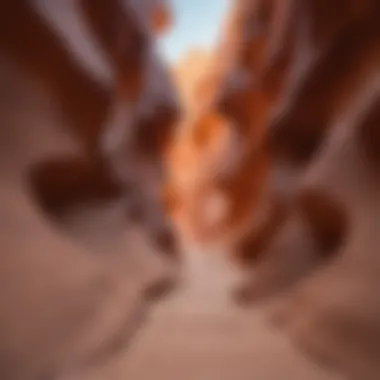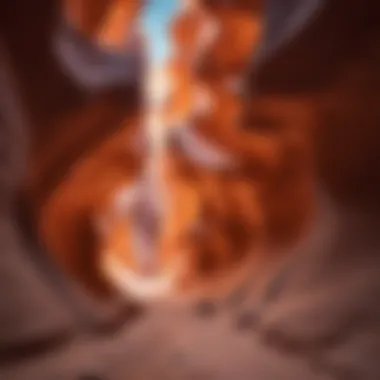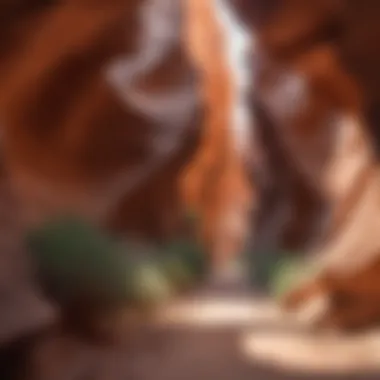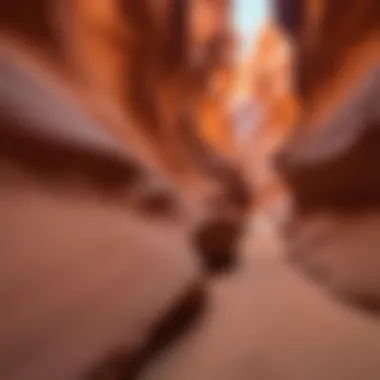Discovering Antelope Canyon Hiking Trail: A Complete Guide


Intro
Antelope Canyon, a dazzling slot canyon located in Arizona, enchants visitors with its narrow passageways and stunning light beams that pierce through the rocky ceiling. The breathtaking play of light and shadow creates an almost surreal atmosphere, making it a favorite spot for photographers and nature lovers alike. This natural wonder is not just a visual spectacle; it's a place steeped in both geological history and ecological significance.
As we embark on this exploration of the Antelope Canyon hiking trail, it’s vital to understand what makes this trail unique. From the rich soil that contributes to the vibrant ecosystem to the careful preservation efforts that maintain its pristine beauty, every step in Antelope Canyon provides connections to the land and its history.
In this guide, we'll cover various aspects of the trail, such as how to access it, safety measures to keep in mind, and ways to engage responsibly with this delicate environment. Additionally, we'll dive into the fascinating geological features that shaped the canyon over millennia and the ecological importance of this area that supports rich biodiversity. Whether you're an experienced hiker or a newcomer to outdoor adventures, the insights shared here aim to enhance your experience as you navigate this remarkable landscape.
Foreword to Antelope Canyon
Antelope Canyon is more than just a beautiful landscape; it is a remarkable symbiosis of geological formation and historical relevance. This enchanting slot canyon located near Page, Arizona, draws outdoor enthusiasts and nature lovers alike. Understanding the depths of Antelope Canyon allows one to appreciate its beauty while recognizing the responsibility that comes with exploring such a delicate ecosystem.
One of the profound aspects of this canyon is its ethereal light beams that grace the canyon walls, creating an almost spiritual ambiance that many describe as transformative. This experience isn't just visual; it invites hikers to reflect on the forces of nature that have sculpted this land over centuries. With a variety of hiking paths available, ranging from casual strolls to more demanding treks, Antelope Canyon caters to a broad spectrum of abilities and interests.
In this section, we delve deeper into the canyon’s geographical location and its historical significance, revealing the intricacies that make this destination unique. By arming hikers with knowledge about the canyon's features, we can cultivate a sense of respect and ensure that our visits are mindful and eco-friendly.
Geographical Location and Overview
Antelope Canyon is nestled within the Navajo Nation in northern Arizona, a stone's throw from the breathtaking Lake Powell. The canyon comprises two main sections: Upper Antelope Canyon and Lower Antelope Canyon, both showcasing stunning waves of sandstone in hues ranging from golden ochre to fiery red, especially during the midday sun when the light dances through the narrow openings above.
The geography of Antelope Canyon is characterized by its narrow corridors, which were formed through the constant flow of rainwater that eroded the soft Navajo sandstone over time. As hikers wander through these naturally carved pathways, they are enveloped by towering walls that rise up to 120 feet high in some locations. This visual spectacle, combined with the sound of water that frequently flows during storms, creates an unmatched experience.
Why Location Matters
Understanding the location is fundamental to appreciating the unique conditions that allow Antelope Canyon to thrive. These geographical features also introduce prospective hikers to the best times for visits. Generally, the months of March to October offer the most favorable conditions for hiking.
Historical Context
The history of Antelope Canyon is woven through the narratives of the Navajo people, who hold deep cultural significance for this land. Traditionally referred to as "Tsé bighánílini" (the place where water runs through the rock), the canyon has been a sacred space for the Navajo Nation. It is often said that these lands are imbued with stories and legends that have been passed down for generations, intertwining human experience with the majestic landscape.
During the latter half of the 20th century, Antelope Canyon began to attract attention from photographers and tourists alike, eager to capture its breathtaking beauty. Fortunately, this increased visibility has fostered a greater awareness of the need for preservation and responsible tourism practices.
"Visiting Antelope Canyon is not just sightseeing. It’s about understanding a history that shaped this landscape and the people who call it home."
The collaboration between the Navajo Nation and park authorities has led to measures that ensure sustainable tourism practices while allowing visitors to enjoy this enchanting feature of nature responsibly. Knowing this context enhances the hiking experience, making it not only about physical movement but about stepping into a rich tapestry of cultural heritage as well.
Understanding the Canyon's Formations
Understanding the formations within Antelope Canyon is crucial. This knowledge enriches the hiking experience and provides insights into the forces that shaped this remarkable landscape. The canyon's structure reflects not only its geological past but also offers perspectives on how nature evolves over eons. By grasping this intricate tapestry, hikers gain appreciation and respect for the environment they are traversing.
Geological Composition
Antelope Canyon is primarily composed of Navajo sandstone. This rock type is characterized by its unique color variations ranging from deep reds to soft oranges, caused by iron oxide deposits. The sandstone was formed hundreds of millions of years ago, when the area was covered by a vast inland sea. Over time, layers of sediment compacted, turning into stone.
Here are some notable elements of the canyon's geological composition:
- Layering: The distinct horizontal layers of sandstone can be seen throughout the canyon, telling a story of sedimentary processes.
- Fossils: Remnants of ancient marine life can occasionally be found embedded in the rock, providing a window into a distant ecosystem.
- Mineralogy: Besides sandstone, there are traces of other minerals like calcite and gypsum, adding to the canyon's overall beauty and structure.
The interplay of these materials not only creates visually stunning patterns but also contributes to the canyon's structural integrity, which is vital for the safety of hikers navigating its narrow passageways.
Erosion and Its Effects
Erosion plays a pivotal role in shaping Antelope Canyon. The effect of weathering, particularly flash floods and wind, has sculpted the canyon's walls into smooth, wave-like formations, which are a significant draw for photographers and adventurers alike. Over time, these forces have created narrow slot canyons which are both breathtaking and challenging.
Key aspects of erosion in Antelope Canyon include:


- Flash Floods: Sudden, intense rainfalls can lead to flash floods, rapidly changing the landscape and sometimes posing risks to hikers if not properly assessed.
- Wind Erosion: Over time, the relentless wind has carved intricate shapes into the sandstone, creating features known as "whirlwinds" that add character and beauty.
- Rock Fall Dangers: Some areas of the canyon are prone to rock falls due to erosion, making awareness of one's surroundings paramount for safety.
"Understanding erosion helps hikers appreciate the delicate balance of nature and the dynamic processes that shape our planet."
The ongoing erosion not only defines the canyon's beauty but also serves as a reminder of the forces that govern the natural world. For those hiking through Antelope Canyon, recognizing these aspects deepens the experience, making it not just a physical journey, but also an educational one.
Preparing for Your Hike
Preparing for your hike into Antelope Canyon isn’t just about packing a bag and hitting the trail; it’s akin to laying the foundation for a meaningful experience. The canyon’s unique landscape offers not just extraordinary views but also presents challenges that can catch even seasoned hikers off guard. Understanding what to pack and how to condition your body sets the stage for a safe and enjoyable adventure. Not only does preparation enhance your physical readiness, but it also serves to foster a deeper connection with the stunning environment around you.
Essential Gear and Supplies
When embarking on a hike in Antelope Canyon, having the right gear can mean the difference between a pleasurable experience and a frustrating one. This isn’t the kind of trail where you can just throw on a pair of shoes and hope for the best. Here are some essentials to consider:
- Sturdy Footwear: Opt for well-supported hiking boots or shoes with good traction. The canyon’s terrain can be rocky and uneven; a sprained ankle could turn your adventure sour.
- Hydration Pack: Staying hydrated is critical, particularly in the warm climate of the Southwest. A hydration pack allows for easy access to water while keeping your hands free.
- Appropriate Clothing: Wear moisture-wicking layers that can handle temperature changes. Mornings might be chilly, but the sun can heat things up quickly. Remember, lightweight long sleeves can protect against UV rays.
- First Aid Kit: Always prepare for minor injuries. A compact first aid kit with the basics is a smart move.
- Navigation Tools: Even in well-mapped areas, a GPS device or a physical map can provide peace of mind, especially if trails intertwine.
Don't forget to check weather conditions prior to your hike, as conditions can shift unexpectedly.
Physical Conditioning Tips
Just as crucial as gear is physical fitness. Hiking Antelope Canyon requires not just enthusiasm but also some level of stamina and strength. Prior to your journey, here's how to ramp up your physical conditioning:
- Cardiovascular Fitness: Consider incorporating activities like running, cycling, or swimming into your routine. Aim for at least 30 minutes of moderate intensity, three to five times a week. This builds your endurance, essential for handling inclines and longer routes.
- Strength Training: Focus on your core, legs, and back to ensure you can navigate any rocky obstacles with ease. Exercises like squats, lunges, and planks can be particularly beneficial.
- Flexibility: Stretching should not be overlooked. Regular stretching can help prevent injuries and improve your range of motion during your hike.
- Practice Hikes: If possible, find local trails that mimic the terrain of Antelope Canyon. This provides not only physical conditioning but also familiarizes you with the hiking experience.
"Well-prepared hikers are not just participants in nature; they become part of it, more aware of their surroundings and attuned to its rhythms."
By focusing on essential gear and maintaining a fitness routine that suits the demands of the trail, you position yourself to dive into the captivating beauty of Antelope Canyon with confidence. The preparation you invest not only enhances your safety but also enriches your overall experience, allowing you to connect more deeply with this remarkable landscape.
The Hiking Experience
Hiking through Antelope Canyon offers a transformative experience, where nature’s artistry combines with physical activity. The intimate encounter with the canyon's unique slot formations, colors, and textures underscores why many choose this as a hiking destination. The act of hiking here is not only about following a path; it’s about sensory immersion in an ancient landscape that has been sculpted over millennia. Hikers can experience the shifting light within the canyon, which transforms the sandstone walls into vibrant hues of orange and red, creating a visual experience unlike any other.
By exploring this trail, hikers gain insights into the intricate balance of nature's forces—from erosion to flash floods—that shaped this environment. Furthermore, the adventure promotes both mental clarity and physical well-being; the rhythmic cadence of footsteps on sandy surace serves as a meditative practice.
Trail Access Points
Antelope Canyon can be accessed through two primary sections: Upper Antelope Canyon and Lower Antelope Canyon, each offering distinct experiences.
- Upper Antelope Canyon is often favored for its accessibility; the entry point is straightforward, making it a top location for photographers and casual hikers. Guided tours lead visitors through the narrow passageways, ensuring that they don't miss key photo opportunities.
- Lower Antelope Canyon, while a bit more rugged and requiring some climbing, rewards those who venture with stunning views. The winding passageways provide a sense of adventure that contrasts elegantly with the easier Upper Canyon paths.
Recommended Routes and Distances
When it comes to hiking distances and routes, the canyon offers paths suitable for different skill levels. On average:
- Upper Antelope Canyon has a short walking distance of about 1.5 miles. Most guided tours take approximately 1 to 1.5 hours depending on the crowd and the photo stops. The trail is well-marked, making it user-friendly for those less experienced.
- Lower Antelope Canyon features a longer stretch at about 2.5 miles, allowing for deeper exploration. This route often takes 2 hours for a complete round, providing more opportunities to absorb the natural environment.
Hikers should be aware of their fitness levels and choose the route that best suits them, ensuring a safe and enjoyable experience.
Scenic Highlights Along the Route
Each step into Antelope Canyon unveils breathtaking scenery that tells stories etched in stone. Among the notable highlights are:
- The Light Beams: Particularly prominent when visiting during midday, these captivating beams of light filter through the narrow openings above, creating an ethereal atmosphere.
- The Wave: Known for its uniquely smooth, wavy appearances on the canyon walls, it’s a must-see for photography enthusiasts.
- Sandstone Formations: Various formations in the walls, resembling faces or figures, spark the imagination and invite one to pause and reflect.
"The beauty of Antelope Canyon is not just in what you see, but in how it ignites the senses, prompting awe and reflection as nature's artistry unfolds."
Hiking through Antelope Canyon immerses visitors in a stunning natural gallery, leaving an indelible mark on the hearts of those who partake. Whether you’re chasing the optimum lighting for photography or seeking solace in nature, the hiking experience here is indeed a journey worth undertaking.


Navigational Challenges
When traversing the Antelope Canyon hiking trail, you may encounter obstacles that test your skills and resilience. It’s not just about admiring the stunning visuals but also about understanding the intricate dance of navigating through an environment that can be as unpredictable as it is beautiful. Knowing these navigational challenges becomes essential for any hiker, especially for those looking to embrace the canyon's enchanting allure without falling prey to its potentially perilous aspects.
Hazardous Weather Conditions
The weather in Antelope Canyon can change faster than a flick of a switch. Extreme temperature shifts during the day can leave hikers feeling either like they're in a furnace or a freezer. Morning starts often bring a fresh chill, while afternoons can soar well into the hundreds, particularly in summer. You can easily find yourself sweltering in the sun with very little reprieve. Keeping hydrated is non-negotiable—think about bringing more water than you usually would; it’s better to have it and not need it than to need it and wish you had packed more.
Rainstorms might seem far from the forefront of your mind, but they're a serious consideration. Flash floods can sweep through narrow slots of the canyon with alarming swiftness. A sunny day at the canyon doesn’t guarantee safety—those storms can brew far away, causing a deluge well upstream that turns your leisurely trek into a race against rising water levels. Always check the weather forecast before heading out, and if you spot ominous clouds gathering, it’s wiser to abort the mission than to press on. Remember, the rugged beauty of the canyon can turn into a treacherous terrain within minutes.
Consider keeping an eye on the wind as well. High winds can kick up dust and debris, impairing your vision. Always ensure to face the wind direction while moving—this simple trick can help keep your senses sharp and improve your awareness of the environment surrounding you.
Wildlife Encounters
The hiking trail of Antelope Canyon is not just a feast for the eyes; it's also home to various wildlife that thrive in this unique ecosystem. From the coyotes howling in the distance to the occasional rattlesnake basking on a rock—each excursion could bring a different encounter that might catch you off guard.
While the canyon is not teeming with large mammals, smaller creatures like lizards, birds, and rabbits can frequently be seen scurrying about. One must always be mindful of where they step; there’s no telling when you might inadvertently wander too close to a den of skunks or a nesting ground for local birds. Best to respect their space and let them be. After all, you’re a visitor in their territory.
Moreover, it’s crucial to understand that certain wildlife can be potentially hazardous. Rattlesnakes, for instance, may wait quietly under boulders, hidden from sight. Their presence, while typically harmless unless provoked, honestly demands vigilance. If you take a wrong step, it might land you with a nasty surprise that could have been avoided with some careful maneuvering.
So when you set out for your hike, consider donning sturdy boots and long trousers to minimize exposure to bites or stings. Keeping your distance and avoiding direct interaction with any wildlife can enhance both your enjoyment of the trail and the safety of your expedition.
"Preparation is the key to safety. Staying aware of environmental cues and being respectful of wildlife can make your adventure in Antelope Canyon a truly rewarding experience."
In summary, the navigational challenges at Antelope Canyon are both diverse and demanding. It requires a blend of respect for the natural elements and an understanding of the local fauna. Being prepared means you can fully embrace the majestic beauty of this remarkable place, and come away with memories that’ll last a lifetime.
Safety Considerations
When embarking on the journey through Antelope Canyon, it is imperative to prioritize safety. The unique beauty of this natural wonder camouflages the potential challenges that await those unprepared. Safety considerations are not merely checkboxes on a list; they represent the meticulous planning and awareness necessary to ensure a rewarding experience rather than an arduous one.
Assessing Personal Health and Fitness
Before lacing up hiking boots, self-assessment becomes key. The physical demands of Antelope Canyon are not insignificant. The trails can be rocky, steep, and sometimes challenging to navigate. It is advisable to evaluate your overall fitness level before undertaking this excursion.
- Cardiovascular health: Consider your stamina. Hiking through diverse terrains can test cardiovascular endurance. If you’re not accustomed to vigorous exercise, take gradual steps to build your fitness.
- Joint health: Many hikers experience discomfort in their knees and ankles on uneven ground. Ensure that you are conditioned and, if necessary, consult a physician about any past injuries.
- Hydration and Nutrition: Staying hydrated is not just a tip but a requirement. Always carry enough water and possibly some energy snacks, like nuts or granola bars, to help maintain energy levels on the go.
Being honest about your capabilities can mean the difference between a successful hike and one mired in discomfort.
Navigation and First Aid Skills
Antelope Canyon's mesmerizing formations can easily distract one from the more practical aspects of hiking, such as navigating the trail and potential first aid responsiveness. A couple of essential skills and tools can make a world of difference.
- Map Reading: Familiarize yourself with the terrain by studying topographic maps beforehand. Some parts of the canyon can seem like a labyrinth, so developing a sense of direction will help. If your phone loses service, having a physical map ensures that you won't be stuck wandering around.
- Essential Gear: Carry a compass and a reliable GPS device. Though the trails may seem marked, the canyon's twists and turns can challenge even seasoned hikers.
- First Aid Basics: Knowing first aid can be invaluable when the unexpected happens. Having a basic first aid kit on hand is crucial. Pack items like band-aids, antiseptic wipes, and pain relievers.
- Emergency Techniques: Brush up on CPR and basic wound care; both can be life-saving skills when faced with urgent situations in the wilderness.
"Preparation is not an option but a necessity when venturing into the wild."
Understanding these safety considerations can significantly enhance your hiking experience. Rather than seeing them as restrictions, consider them as tools in your backpack—essential for a fulfilling exploration of Antelope Canyon.
Respecting the Environment
Respecting the environment while hiking in Antelope Canyon is paramount for numerous reasons. The canyon is not just a breathtaking visual feast; it is also a fragile ecosystem teeming with unique flora and fauna. Visitors, whether seasoned hikers or first-timers, must recognize their impact on this delicate environment, ensuring that their presence does not cause irreversible harm. The overarching principle here is that enjoyment of nature should go hand-in-hand with preservation, fostering a sustainable approach to exploration.
Leave No Trace Principles
Understanding and implementing Leave No Trace principles is vital for anyone venturing into Antelope Canyon. These principles help minimize human impact and encourage responsible outdoor practices. Here are the key components:


- Plan Ahead and Prepare: Before heading out, consider the season and the expected weather conditions. Antelope Canyon can be unforgiving; knowing what to expect will help you prepare adequately.
- Travel and Camp on Durable Surfaces: Stick to established paths and avoid trampling on vegetation. Remember, the greenery in the canyon is not just pretty; it’s essential for stabilizing the soil.
- Dispose of Waste Properly: It might seem elementary, but it bears repeating: pack out everything you pack in. This includes food scraps, water bottles, and other disposables. Encourage fellow hikers to do the same.
- Leave What You Find: Natural artifacts are often home to ecosystems and play a role in the local ecology. Refraining from taking natural souvenirs, like stones or plants, is crucial for maintaining the area's integrity.
- Minimize Campfire Impact: Open flames can cause severe damage to both the surrounding fauna and flora. It’s best to avoid campfires altogether and instead bring a portable stove.
The implementation of these principles not only enhances the experience for current and future hikers but also protects the unique iris of Antelope Canyon for years to come.
Cultural Heritage and Preservation
An often overlooked aspect of hiking in Antelope Canyon is its cultural heritage. The canyon has immense historical significance for the Navajo Nation, which has a deep spiritual connection to the land. Recognizing and respecting this cultural context is vital for a responsible hiking experience.
Visitors are urged to reflect on the following:
- Understand the History: The Navajo people view Antelope Canyon not just as a stunning geographical formation but as a place of significance connected to their identity and traditions.
- Participate in Educational Opportunities: Engaging with local guides or joining informational tours can provide invaluable insights into the traditions, stories, and beliefs associated with the canyon.
- Respect Local Customs: When hiking, maintaining a level of decorum in your behavior is important. Many aspects of the canyon might be sacred or hold deep meaning, and being mindful of this enhances the overall experience.
- Contribute to Preservation Efforts: Consider donating time or resources to organizations focused on preserving the cultural and natural integrity of the canyon. Many local initiatives appreciate contributions that pave the road for better environmental stewardship.
In embracing these aspects, hikers do not just enjoy the spectacle of Antelope Canyon, but they also contribute to a greater understanding and respect for the land and its original inhabitants.
"To walk in the canyon is to walk through history and the spirit of the land itself. Respect for this legacy forms the foundation for sustainability."
By understanding the intricate relationship between nature and culture, visitors to Antelope Canyon can significantly enrich their experience and help ensure that this natural wonder remains a vibrant part of the earth for many generations to come.
Post-Hike Considerations
After traversing the stunning landscapes of Antelope Canyon, it is essential to take time for post-hike considerations. Engaging with nature can leave you invigorated yet tired. Assessing how best to recover and share your experience responsibly can enhance the benefits of your adventure. These aspects are especially crucial not only for your physical well-being but also for fostering a culture of conservation among fellow outdoor enthusiasts.
Physical Recovery Techniques
Recovery after a hike can make a world of difference in how your body feels and how quickly you bounce back for your next outing. Here are several practical strategies:
- Hydration: Replenishing fluids lost during the hike is vital. Water, of course, is the go-to drink, but incorporating electrolyte-rich beverages can help brace the body back into balance.
- Stretching: Once you've settled in, incorporate gentle stretches to ease muscle tightness. Focus on the legs and back—these areas typically bear the brunt of a long hike. Think simple stretches like calf raises and torso twists to encourage flexibility.
- Rest and Nutrition: Give your body the chance to repair itself. A balanced meal that includes proteins, carbohydrates, and healthy fats will help rejuvenate your energy stores. A hearty post-hike meal can be just as satisfying as the hike itself, offering a satisfying conclusion to your adventure.
- Warm Bath or Shower: Time spent soaking in a warm bath can be beneficial for soothing sore muscles. Consider adding Epsom salt to your bath—magnesium can alleviate muscle tension and fatigue.
Establishing a recovery ritual post-hike sets the stage for future excursions, allowing for better endurance and enjoyment during subsequent trips.
Sharing Your Experience Responsibly
Once you’ve recovered, sharing your adventure with others can amplify your experience and foster a greater appreciation for the great outdoors. However, doing this responsibly is key. Here are a few pointers on how to go about it:
- Social Media Etiquette: When posting photos, avoid showing any sensitive areas that could lead to over-exposure of the canyon. Antelope Canyon thrives on natural beauty, and sharing responsible shots can inspire others to respect it. Use hashtags wisely—opt for ones that promote conservation and responsible travel.
- Storytelling: Narrating your journey is more than just sharing highlights; it’s about conveying the lessons learned along the way. Discuss the beauty and fragility of the environment. Include tips that might help future hikers better navigate their own adventure.
- Encourage Awareness: Utilize your platform to remind others about the importance of adhering to Leave No Trace principles. Share personal experiences that might resonate deeply, urging others to think twice before leaving behind trash or venturing off-trail.
"We do not inherit the earth from our ancestors, we borrow it from our children."
Adhering to these ideas not only enriches your own hiking experience but simultaneously fosters a collective responsibility towards nature conservation.
Epilogue
In wrapping up the exploration of Antelope Canyon's hiking trail, it's essential to recognize the significant benefits and considerations that arise from engaging with this unique landscape. Hiking through the canyon is not just an adventure; it’s an opportunity to connect deeply with nature. The intricate rock formations and the play of light through the narrow crevices provide an experience that transcends the ordinary. It’s a lesson in geology, ecology, and respect for the environment we inhabit.
The Value of Hiking Antelope Canyon
Hiking Antelope Canyon serves multiple purposes—both for the individual and the broader community. First, it encourages physical activity and mental well-being. The act of traversing this stunning terrain can be a form of meditation, where each step amidst the unforgettable beauty offers a chance to reflect and rejuvenate.
Moreover, experiencing the unique geological features firsthand enriches one’s understanding of natural history and earth sciences. As hikers navigate the winding paths, they immerse themselves in the canyon's story, observing how erosion and sedimentation sculpted this visually mesmerizing landscape.
It’s also vital to consider the cultural significance of Antelope Canyon. For many, it embodies sacred spaces, rich in stories and history significant to Native cultures. By hiking the canyon respectfully, one honors these traditions and recognizes the importance of preserving this natural treasure.
- Enhances physical health: By engaging in a challenging hike, one can improve cardiovascular fitness and muscle strength.
- Fosters mental clarity: Spending time in such breathtaking surroundings has proved beneficial for mental health, reducing stress and improving overall mood.
- Promotes environmental stewardship: Understanding the fragility of such ecosystems encourages hikers to adopt environmentally responsible behaviors.
Future Perspectives in Conservation and Hiking
Looking forward, the balance between conservation and increased visitation to Antelope Canyon becomes paramount. With the surge of popularity for national parks and natural wonders, there is an urgent call for sustainable practices among visitors. New initiatives have to be implemented to ensure that the canyon remains unspoiled for future generations while still welcoming hikers.
Educational programs could play a critical role in this respect. Workshops aimed at informing visitors about the ecological and cultural importance of the canyon can deepen appreciation and foster a sense of responsibility. Furthermore, guided walks led by knowledgeable speakers can enhance the experience, providing insights that casual hikes might overlook.
As hiking trends evolve, technology may also contribute positively through apps that promote responsible hiking habits and tips for best practices in the outdoors. Utilizing this tech-savvy approach can lead to more informed hikers who prioritize care for the environment.
The ongoing discussions about conservation efforts should also include local communities' perspectives, ensuring their voices are heard in decision-making. Establishing partnerships with these stakeholders can yield beneficial outcomes, fostering developments that preserve the canyon's integrity whilst promoting tourism.



